|
MANY PACHECO FAMILY COAT OF ARMS
WITH ONE COMMON DENOMINATOR.
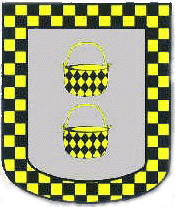 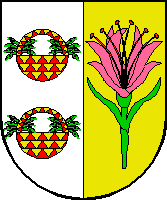 
 
Escudo de plata, dos
calderos jaquelados de oro y sable. Bordura jaquelada de lo
mismo.
Thanks to;
http://www.vicentepacheco.com/escudo.html and others.
History of the Pacheco Family
Name in Spain.
Open Conflict: Tendilla versus the Letrados
[150] One Mendoza was not willing to
abdicate the role of leader. While the family in Guadalajara accepted the
inevitability of this changing intellectual leadership with a graciousness
verging on indifference, the count of Tendilla in Granada fought against the
trend. Conservative by nature and alienated from his Guadalajara cousins by
property disputes, Tendilla's family loyalties were directed toward the
ancestral reference group rather than to the extended family of his own day.
From Tendilla's point of view, the family's political power, its place in
society, its heroes all were associated with the Trastámara revolution and
with the view of Castilian politics and history laid out by Pedro López de
Ayala. Tendilla's adherence to the family's tradition, even at the expense of
family unity, was reinforced by his two journeys to Renaissance Italy and by
his isolation from the new intellectual centers of Castile. When Tendilla
tried to persuade the consejo real to adopt his policies, however, it was not
just an academic dispute over intellectual issues. For Tendilla, as royal
governor of Spain's largest convert population in a period of political and
religious upheaval, every royal decree held life and death implications.
Tendilla did not realize until too late that in a society that had come to
regard tolerance and moderation as deviance, it was no longer profitable to
maintain the Mendoza family tradition.
Iñigo López de Mendoza, second count of
Tendilla, was the eldest son and namesake of the first count of Tendilla (d.
1479). He was educated in the household of
his paternal grandfather and namesake, the first marquis of Santillana. He
received his political and military [151] apprenticeship in the
households of his father and his uncle, cardinal Mendoza. His father inherited
one of the mayorazgos created by Santillana; but with three sons and two
daughters to provide for, he tried to increase his estate by service to the
king. He was one of the staunchest supporters of Enrique IV and served as the
king's ambassador to Nicholas V in 1454 and to Pius II in 1458. Tendilla, then
sixteen years old, and his younger brother, Diego Hurtado de Mendoza,
accompanied their father to Florence and Mantua on this second embassy. In
1467, the father was rewarded for his services with the title of count of
Tendilla, and he was appointed tutor of the king's daughter, Juana, who was
taken to live in the Mendoza family residence in Buitrago.
After Enrique disavowed Juana's rights to the
throne in 1468, the first Tendilla and his brother, the future cardinal,
appealed to the papacy for a restitution of her rights and publicized this
appeal by nailing copies of it to the doors of the churches in several
important towns. When the appeal failed, the elder Tendilla handed Juana over
to her new tutor, Juan Pacheco, and seems to have
retired from active public life. Young Tendilla and his brother, Diego Hurtado,
then entered the household of their uncle, the cardinal, and formed part of
his entourage during the summer of 1472 when he entertained the papal legate,
Rodrigo Borgia, and arranged Mendoza support for Isabel as heiress of Enrique.
Tendilla and his father stayed out of the early stages of the ensuing
succession war, and they are the only Mendoza not mentioned in Isabel's
statement of gratitude for the family's support in 1475. Apparently the elder
Tendilla remained loyal to Juana, but he also refused to support Juana against
his own family and stayed out of the conflict in order to preserve the
family's unity.
The second Tendilla inherited his father's
title and estates in 1479; and in the next twenty-five years, he more than
compensated for the disadvantages of having withheld early support from the
winning side. He did this through the Mendoza's traditional route to power and
wealth -- outstanding military service in the wars against the Muslims, heavy
investment of his private fortune in the diplomatic and administrative service
of the crown, and a politically and financially profitable second marriage. In
addition, he and Diego Hurtado were favorites of their uncle the cardinal; and
through the cardinal's patronage, Diego Hurtado became bishop of Palencia
(1473), president of the consejo real (1483-1486), and archbishop of Seville
(1485). Diego Hurtado followed in the footsteps of his uncle in more ways than
one: he too fathered illegitimate sons, became cardinal of Santa Sabina, and
resided at the royal court as protector of the family interests. With such
[152] alliances, Tendilla's career was bound to be favored by the Catholic
Monarchs; but Tendilla himself was a man of exceptional political and military
talents and had all the personal characteristics that modern historians
consider typical of the Mendoza at their best -- charm, courage, boundless
pride, lively intelligence, sparkling wit, shrewdness, and prudence. Above
all, Tendilla displayed a flair for cutting the Gordian knot with a wit and
ingenuity that made him a legend even in his own lifetime.
In 1480, Tendilla married
Francisca Pacheco, a daughter of Juan Pacheco,
his father's rival as tutor to the princess Juana. This marriage culminated a
series of moves taken by the Mendoza in 1478-1480 to prevent the destruction
of the Pacheco Family by Isabel in the succession war. By this marriage, the Mendoza
allied themselves with their traditional rivals in order to preserve that
balance of powers within the kingdom typical of the Enriquista political
structure; and Tendilla allied himself with a family already powerful in
Andaluda and active proponents of war against Granada.
Diego Rodriguez de Silva y Velazquez
Spanish painter, b. at Seville 5 June, 1599
(the certificate of baptism is dated 6 June); d. at Madrid, 7 August, 1660.
His father, Juan Rodriguez, belonged to the Portuguese family of Silva; the
child took the name of his mother, Gerónima Velazquez. He entered the studio
of the aged Herrera, but could not stand his temper, and soon left for the
studio of Francisco Pacheco, whose school at Seville was the most frequented.
Although one of the most tiresome of romanticizing painters, Pacheco was a
cultured mind, appreciative of a genius opposed to his own. As a critic, poet,
and man of the world, Pacheco was the centre of the first literary salon in
the city, and from this society young Velazquez received an education through
contact and conversation with superior men. Before he was twenty he had
married Pacheco's daughter Dona Juana. Two daughters were born to him before
1622, when the young painter decided to seek his fortune at Madrid.
Here, through Canon Fonseca, a friend of his,
who held a post at Court, he was enabled to visit the royal collections at the
Alcazar, Prado, and especially the Escorial, with its matchless collection of
Tintorettos and Titians. This was the sole benefit of his visit, and after
some several months Velazquez returned to Seville. When Philip IV raised the
Sevilian Olivarez to power, Fonseca summoned Velazquez back to Madrid, and he
obtained permission to paint the king's portrait in the court of the riding
school. This portrait, now lost, was an event. Thenceforth Velazquez had the
exclusive right to paint the person of the king. By a patent of 31 October,
1623, he was appointed painter of the chamber, with a salary of twenty ducats
payable out of the appropriation for court surgeons and barbers.
A BRIEF HISTORY OF ESTEPONA
(Costa del Sol)
Its history involved the Phoenicians, the
Romans and the Arabs. The latter, who settled in this region the longest, left
us numerous vestiges of which very few have unfortunately been saved
(fortifications, watch towers, etc.).
In the strictest historical sense, however, we
are obliged to admit that it is not known when the town was founded. This
might well fall within the time of the Phoenician settlements, and there are
considerate grounds to believe that it might have been during the Roman era.
It is therefore assumed that the Estepona of old existed a good deal earlier
than the Arab "Estebbuna" and "Alextebuna".
The town was captured from the Arabs during the
hostilities ordered by King Henry IV of Castilla in the year 1456. It is from
this moment on that the history of Estepona as it is known today began, with
the very same King Henry ordering the reconstruction of the castle at the
request of his intimate friend and advisor, Don Fernández Pacheco, the Marquis
of Villena.
In the absence of the Catholic Kings, during
the reign of Doña Juana La Loca, or "Mad Jane", the village remained under the
jurisdiction of Marbella.
With more than 600 inhabitants, Estepona
obtained its complete and unrestrained independence under King PhiIlip V, "In
perpetuity and for always without end in all manner of civil and criminal
matters of the first instance within the town and its municipal district", as
is recorded literally in the town Charter signed by the King himself in
Seville on the 21 April 1729 and which is kept in the town archives.
From this moment on its development began in
earnest using its own natural resources, the sea (fishing) and the countryside
(crops), until today and the beginning of the tourist phenomenon.
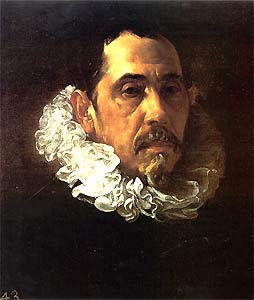

The Writings of Francisco Pacheco
(1564-1644).
'To write history properly has always been
difficult'. With these words Francisco Pacheco, painter and writer in Seville,
described the task of writing an account of the life of the humanist Benito
Arias Montano and, generally, of other eminent personalities of his times.
Francisco Pacheco, otherwise known as the master of Diego Silva y Velázquez,
was a diligent writer. As sometimes happened in seventeenth century Spain,
Pacheco never saw his books printed while he was alive. The Arte de la
pintura (Seville 1649) had no influence until the eighteenth century
onwards, whereas the manuscript-book, Libro de descripción de verdaderos
retratos de ilustres y memorables varones (dated Seville 1599 in the
frontispiece) was quite renowned among scholars and writers of the time, but
never got to the press until the end of the nineteenth century.
My research on Pacheco's writings is focusing
in the Libro de retratos and its relations with the historical and
cultural history of Seville in the sixteenth and seventeenth centuries.
Seville was, then, one of the richest and most cosmopolitan cities of Europe,
second only to cities like Naples and Paris. Nevertheless, Pacheco was living
in an in-between age. The dawn of the seventeenth century would usher in the
critical years of Spanish decadence and the loss of control over Europe by the
Spanish empire. Through fifty-six portraits and biographies of eminent
individuals in Spain at the turn of the century, Pacheco acquaints us with the
cultural issues of his age, the social systems and hierarchies, and the
changes brought in by the Counter-Reformation.
The book represents the diverse social ranks
that were to be found in cultivated Spain: a King (Philip II), a town
councillor (venticuatro), poets and writers, soldiers, preachers,
painters, a doctor, a musician, a dancer, a goldsmith. Pacheco shows a dynamic
society that travels to America as well to nearby Africa in search of gold,
convents to Christianity, and mercantile contacts.
Several Spanish contemporaries of Pacheco knew
about the existence of the book, such as the renowned writer Francisco Quevedo
who mentioned the volume in a poem, and the historian and antiquarian Rodrigo
Caro, who reflected in his Varones ilustres. Pacheco was probably aware of
having introduced a new historical genre into his country: half-way between a
chronicle and a collective biography, the Libro de retratos was forgotten
until its facsimile publication by the bibliophile José Maria Asensio at the
end of the nineteenth century. This edition was a success and was followed by
two more in the 1980's.The book is still quoted by Spanish and non-Spanish
historians alike who study personalities of the seventeenth century. Pacheco's
book happens to be one of the handiest primary sources that still mentioned in
essays and biographies. Nevertheless, the text by Pacheco has not been studied
in depth. It still lacks a critical edition and a study of the author.
Information contained in the Libro is cited regardless of his authenticity by
scholars who are content to praise it as mine of data without subjecting it to
any academic analysis.
My PhD is focused in the historical and
biographical contents of the Libro de los retratos. A large part of my
thesis is concerns Pacheco's writing technique, i.e. how did he select the
individuals (eminent and otherwise) and how did he gather the data about them.
From my consultation of sources in Madrid (Biblioteca Nacional, Academia de
Historia, Biblioteca Lázaro Galdiano, Instituto Valencia de Don Juan), Seville
(Biblioteca Capitular y Colombina, Archivo Nacional), London (British Library)
and Oxford (Taylorian). I have identified a large number of Pacheco's sources,
in both manuscript and early printed form. Pacheco's use of them is surprising
to the modern reader; plagiarism is common, but not automatic. The Inquisition
was a lively presence for the author when he was compiling the book: all
allusions to heresy and heterodox views are removed. Nevertheless, I still
need to look into further comparative material and to investigate into
possible patrons of Pacheco's oeuvre and to establish Pacheco's links with the
Church and the Inquisition (Pacheco's brother was, in fact, an inquisitor). I
also wish to look into the historical genres of biographies, chronicles and
histories of Seville. A detailed comparison with the contemporary historian
and friend of Pacheco, Rodrigo Caro is crucial. Finally a comparison with
Pacheco's second book, the Arte de la pintura is essential, and it should also
highlight the differences between Pacheco the painter and Pacheco the writer. Marta Cacho Casal
martacasal@hotmail.com
Belmonte
The province of Cuenca is one of five
provinces within the region of
Castilla-La-Mancha, the other four being Guadalajara,
Toledo,
Albacete and Ciudad Real. The whole area has some of the most historic and
beautiful lands within the whole of Spain. Remains of burial grounds dating
from the Iron Age have been discovered as well as some major Roman settlements
such as those at Saelices and Valeria.
A monumental town of great interest with many,
well preserved architectural gems, not least of all its castle. It was Henri
IV who gave the town to Juan Pacheco, the Marquis of Villena in 1456 .
The castle was erected in the 15th century, on top of a hill in order to
protect the Marquis's domain.

It was built
by Juan Pacheco in 1456-1470 on the site of an
earlier castle dated 1324. It was restored at one point and used as a private
residence. The walled precinct whose 15th-16th century ramparts and gates
connect the old town with the castle is particularly well preserved. Belmonte
has more than its fair share of churches, palaces and convents. The hermitage
of Nuestra Senora de Gracia, dated 17th century is certainly worthy of a
visit.
HISTORY
During the 12th + 13th
centuries, the muslim almohad population of Spain built castles to check
the christian advance. The origins of the castle of the watchtower of Villena
go back to these times. In the middle of the 13th century the
christian troops in the service of games of Aragon twice failed to capture the
castle, until the knight commander of Alcañiz, of the order of Calatrava,
finally conquered the the city of Villena in the name of Jaime I, who then
ceded it to the Castilian King Ferdinand III. The castle passed into the hands
of his last son Don Manuel and from this moments Villena became the head of a
domain which became increasingly important due to its geographical situation
and also to the members of the Castilian royal family who governed in the
city.
On the death of the prince, his son Don
Juan Manuel inherited the fortress which remained the property of the Manueles
until they were incorporated into the crown of castle. The domain of Villena
became a marquisate taking in the lands of Alicante, Albacete, Cuenca, Toledo,
Murcia, Valladolid and Guadalajara. There are no traces of the first marquis,
Don Alfonso of Aragon, in the castle but his successors, Don Juan Pacheco
(first shield), had
the upper part of the homage tower built and his coat of arms appears on one
side of it.
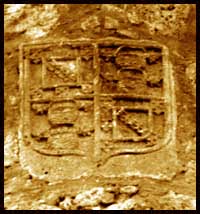 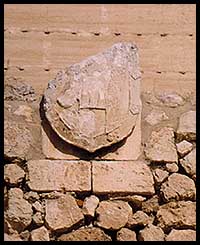
Later, in the time of Ferdinand and Isabella, the people of Villena
rose in
revolt against their marquis, Don Diego López Pacheco and since then the city
and the castle passed into royal control while the title of marquisate became
an honorary one.
The domain of Villena also became a
dukedom, created by Henry III of the castle for the princesses Doña Maria and
Doña Catalina.
The castle played on important role in
the war of the Spanish Succession (1700-1714) serving as a refuge to those
loyal to Philip V of Borbon fighting against Charles of Austria; also, in the
peninsular war, in 1813, Marshal Suchet bombarded the fortress, destroying
same of the almohad domes.
The current state of the fortification
is the result of different initiatives, designed to protect, conserve and make
it better known. The starting point was 1931, the year in which it was
declared a National Historical Monument; later, in 1958, the first restoration
work began. The most recent work dates from the year 2001 and was mainly
focused on the homage tower and the courtyard. Works has already begun an the
restoration of the front section of the wall and further work will be done to restore the whole of the castle.
A LINK TO THE STORY OF
SPAIN THAT INCLUDES THE PACHECO FAMILY.

|